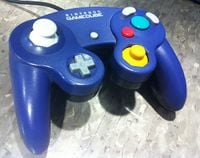Controller modification: Difference between revisions
mNo edit summary |
|||
| Line 1: | Line 1: | ||
{{ArticleIcons|series=y|competitive=y}} | |||
[[File:ModifiedController.jpg|thumb|A modified [[GameCube controller]]; the left analog stick has been replaced with one from a Nunchuk, and the bottom shell has been replaced with that of a black controller.]] | [[File:ModifiedController.jpg|thumb|A modified [[GameCube controller]]; the left analog stick has been replaced with one from a Nunchuk, and the bottom shell has been replaced with that of a black controller.]] | ||
A '''controller modification''' (commonly known as a '''controller mod''') is a cosmetic or functional change to a stock [[controller]]. | A '''controller modification''' (commonly known as a '''controller mod''') is a cosmetic or functional change to a stock [[controller]]. | ||
Revision as of 00:15, June 25, 2022

A controller modification (commonly known as a controller mod) is a cosmetic or functional change to a stock controller.
Cosmetic mods focus on changing the physical appearance of the controller, such as by recoloring the casing or merging two different shells together to form a two-toned controller. Although rarer, other methods of cosmetic changes can also involve placing LEDs into the casing or changing the physical appearance of individual buttons.
Functional mods involve physically altering aspects of the controller, as to improve its function. Common functional mods include changing either the analog sticks, triggers, or the individual buttons. For the analog sticks, common mods focus on replacing worn-down sticks; while most players generally replace analog sticks with those from identical models, combining two different controllers is not an uncommon practice, and those from non-Nintendo controllers, such as DualShock controllers, can be featured. In addition, Brawl, Project M, Smash Wii U, and Ultimate players can choose to remove the springs from the L and R due to the games not recognizing light button presses; Melee players also sometimes alter the length of the springs, as to allow for less resistance to press down the triggers. Finally, other mods involve completely severing the rumble motor from the controller, thus decreasing controller weight and preventing the need to constantly have to switch rumble off.
Common modifications
Cosmetic
- Swapping part or all of the shell with one of a different color/design
- Painting the shell
- Engravements/embossments
Functional
- Fixed/mitigated manufacturing errors
- Control stick/C stick notches (best angles for Sweetspots, Fire Fox, wavedashing, Shield dropping, and drifting.)
- Removed or cut trigger springs
- Trigger plugs
- Recessed buttons/perforated pads
- Replacement of parts with equivalent parts from a different kind of controller
- Rumble motor removal
- Snapback reduction
- Improved button tactility
Tournament legality
In general, modifications are tournament-legal as long as said modifications do not perform actions that could not feasibly be done by an average human. For example, Fire Fox notches are legal, whereas an autofire function would not be. However, there is no unanimously accepted list of legal mods, so legality is on a case-by-case basis depending on the tournament director.
See also
External links
| Controllers and buttons | |
|---|---|
| Nintendo 64 controller | |
| GameCube controller | |
| Wii Remote (and Nunchuk) | |
| Classic Controller | L |
| Nintendo 3DS | |
| Wii U GamePad / Pro Controller | L |
| Joy-Con | |
| Switch Pro Controller | L |
| Third-party controllers | Hori Mini Pad · Arcade controller · Keyboard |
| Other | Smash Controller · Controller modification |